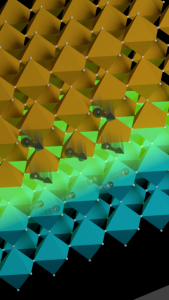At the interface between the strontium titanate and the lanthanide aluminate forms a 2 dimensional electron system. By using a dynamical spin injection technique, we were able to demonstrate a record conversion yield between spin and charge current in this system, moreover that is tunable in amplitude and sign by an electrostatic gate, a premiere.
 The spin–orbit interaction couples the electrons’ motion to their spin. As a result, a charge current running through a material with strong spin–orbit coupling generates a transverse spin current (spin Hall effect, SHE) and vice versa (inverse spin Hall effect, ISHE). The emergence of SHE and ISHE as charge-to-spin interconversion mechanisms offers a variety of novel spintronic functionalities and devices, some of which do not require any ferromagnetic material. However, the interconversion efficiency of SHE and ISHE (spin Hall angle) is a bulk property that rarely exceeds ten percent, and does not take advantage of interfacial and low-dimensional effects otherwise ubiquitous in spintronic hetero- and mesostructures. In a recent study just in Nature Materials, we make use of an interface-driven spin–orbit coupling mechanism—the Rashba effect—in the oxide two-dimensional electron system (2DES) LaAlO3/SrTiO3 to achieve spin-to-charge conversion with unprecedented efficiency. Through spin pumping, we inject a spin current from a NiFe film into the oxide 2DES and detect the resulting charge current, which can be modulated, for the first time, in amplitude and sign by a gate voltage. The amplitude of the effect and its gate dependence is a direct consequence of the electronic structure of the 2DES and highlight the importance of a long scattering time to achieve efficient spin-to-charge interconversion.
The spin–orbit interaction couples the electrons’ motion to their spin. As a result, a charge current running through a material with strong spin–orbit coupling generates a transverse spin current (spin Hall effect, SHE) and vice versa (inverse spin Hall effect, ISHE). The emergence of SHE and ISHE as charge-to-spin interconversion mechanisms offers a variety of novel spintronic functionalities and devices, some of which do not require any ferromagnetic material. However, the interconversion efficiency of SHE and ISHE (spin Hall angle) is a bulk property that rarely exceeds ten percent, and does not take advantage of interfacial and low-dimensional effects otherwise ubiquitous in spintronic hetero- and mesostructures. In a recent study just in Nature Materials, we make use of an interface-driven spin–orbit coupling mechanism—the Rashba effect—in the oxide two-dimensional electron system (2DES) LaAlO3/SrTiO3 to achieve spin-to-charge conversion with unprecedented efficiency. Through spin pumping, we inject a spin current from a NiFe film into the oxide 2DES and detect the resulting charge current, which can be modulated, for the first time, in amplitude and sign by a gate voltage. The amplitude of the effect and its gate dependence is a direct consequence of the electronic structure of the 2DES and highlight the importance of a long scattering time to achieve efficient spin-to-charge interconversion.
This work was done in collaboration with the Spintec and Symmes lab of the Institut Nanosciences et Cryogénie (Univ. Grenoble Alpes, CEA, CNRS) and the unite Mixte de Physique CNRS/Thales (University Paris Orsay, CNRS, Thales).
Reference :
Highly efficient and tunable spin to charge conversion through Rashba coupling at oxide interfaces.
- Lesne, Y. Fu, S. Oyarzun, J.C. Rojas-Sanchez, D.A.C. Vaz, H. Naganuma, J.-P. Attané, M. Jamet, J.-M. George, A. Barthélémy, H. Jaffrès, A. Fert, M. Bibes and L. Vila.
Nature Materials (2016), DOI : 10.1038/NMAT4726




